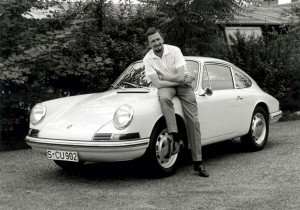As a member of the eponymous Porsche family his name was on the door, as it might be said, but it was the cars Ferdinand Alexander Porsche will be remembered for long after his passing, yesterday, at the age of 76.
Indeed, the most important of those products only recently reappeared in its seventh-generation form, the iconic 911 that still looks much like it did when first unveiled at the 1963 Frankfurt Motor Show.
 “The creator of the Porsche 911 has founded a culture of design in our company that distinguishes our sports cars even today,” said Porsche’s current CEO Matthias Mueller, recalling the influence of Ferdinand Porsche, the grandson of the man who founded the legendary automaker.
“The creator of the Porsche 911 has founded a culture of design in our company that distinguishes our sports cars even today,” said Porsche’s current CEO Matthias Mueller, recalling the influence of Ferdinand Porsche, the grandson of the man who founded the legendary automaker.
Born in Stuttgart on December 11, 1935, and known to friends as “Butzi,” he took a somewhat different path from his father and grandfather, training as a designer rather than an engineer. But he was initially deemed to have little talent, which led to him being dismissed by the examination board at the Hochschule fuer Gestaltungan, an industry design school in Ulm. That didn’t stop Porsche from landing a job at the family firm in the body design department.
It was tradition that members of the family play an active role in the development of every new product, and Butzi Porsche got his chance when it became time to replace the earlier 356.
The new car took a decidedly different approach to its basic design, with an air-cooled, rear-mounted six-cylinder engine. Initially designed the 901 – Porsche sequentially numbering its engineering projects – it was changed to 911 after Peugeot threatened to go to court, claiming a patent on car names using the number “0” in the middle.
Butzi Porsche became the head of the automaker’s design department in 1962 and spent a decade there before pulling back from operational duties. He then set up a design firm, Porsche Design Studios, which has taken on assignments ranging from cars to pens. But it was held in especially high regard for its sunglasses, which some considered as iconic as the 911.
Some used the sort of mechanical wizardry that might seem appropriate to a product named Porsche, such as a saddle-like cushion that, triggered by a cam mechanism, adapted to the shape of the nose.
But Porsche always remained interest in transportation – with his work including trains, motorcycles and even boats.
He returned to day-to-day duties as chairman of the automaker between 1990 and 1993, a time when sales were sliding and it was rumored Porsche might even abandon the U.S., traditionally its largest market.
In declining health, Porsche pulled back from the business world in his later years, though he retained the title of Honorary Chairman of Porsche Cars’ supervisory board.
What’s clear is that his influence remains even after his passing. Marking the launch of the 2012 Porsche 911 last autumn, Butzi Porsche’s latest successor as design director, Michael Mauer, declared “This car embodies the core values for the brand,” adding that while he was proud of his work on the new model he was well aware of the limits placed by the iconic original’s design. Make too many changes, Mauer said, “and it wouldn’t be a 911.”
Ferdinand Alexander Porsche will be buried at the family estate in Zell am See, Austria.

